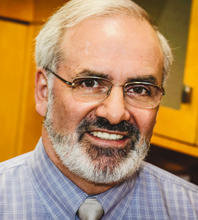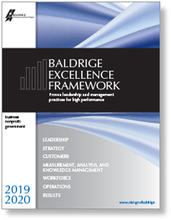Blogrige
The Official Baldrige Blog

2019 Judges Panel Blog Series
Each year we interview the newest members of the Judges’ Panel of the Malcolm Baldrige National Quality Award to share their individual insights and perspectives on the award process, their experiences, and the Baldrige framework and approach to organizational improvement in general.
The primary role of the Judges’ Panel is to ensure the integrity of the Baldrige Award selection process. Based on a review of results of examiners’ scoring of written applications (the Independent and Consensus Review processes), judges vote on which applicants merit Site Visit Review (the third and final examination stage) to verify and clarify their performance in all seven Criteria categories of the Baldrige Excellence Framework. The judges also review reports from site visit to recommend to the U.S. Secretary of Commerce which organizations to name as U.S. role models—Baldrige Award recipients. No judge participates in any discussion of an organization for which he/she has a real or perceived conflict of interest. Judges serve for a period of three years.
Meet Baldrige Judge Christopher Laxton

Christopher E. Laxton
Executive Director
AMDA–The Society for Post-Acute and Long-Term Care Medicine
What experiences led you to the role of Baldrige judge?
I have been working in the nonprofit health care association world for over 35 years. For most of that time, I was frustrated by the wide variability I would see in nonprofit organizational performance. I was looking for a broad-based and nationally normed assessment framework that I could apply to my organization to identify areas of improvement and areas of strength—but for a long time I couldn’t find one that satisfied me.
In 2007, when I was living in Chicago, I went to a conference of my association colleagues, where I sat in on a workshop presented by Paul Borawski, who at the time was the CEO of the American Society for Quality (ASQ). He was introducing the association community in Chicago to the Baldrige Award and the Baldrige Excellence Framework [which includes the Criteria for Performance Excellence]. The Baldrige Award had just been expanded by congressional legislation to include nonprofit organizations in the award eligibility criteria. To say the least, I was intrigued, and afterward I asked Paul how to learn more and get involved. He advised me to apply to be a national Baldrige examiner, which I did right away.
I wasn’t accepted that first year, but I applied again in 2008 and was accepted as a new examiner that year. I have been serving as an examiner for the national program ever since—11 years of reviewing applications, doing site visits, working with and leading teams, and going to training every year. I also started and still moderate the oldest and largest LinkedIn group for national Baldrige examiners and interested others, I have written articles in association magazines, and I have presented workshops of my own discussing the Baldrige Criteria and how the framework can be a roadmap for organizational performance excellence in nonprofit associations.
This year, I was surprised and honored to be selected for the panel of judges for the Baldrige Award. Even though it’s early in my three-year term, I’m already learning new things about the Baldrige Program after 11 years!
Has the judge’s perspective changed your understanding of the Baldrige Performance Excellence Program? If so, how?
I have been impressed with the dedication and expertise of both my fellow judges and the members of the Board of Overseers. What really opened my eyes was the breadth of the program’s reach and the range of its activities beyond the core set of processes used to accept applications, assign examiner teams, and monitor applicant entries for the Baldrige Award as they go through the annual cycle.
I had, of course, heard of the Baldrige Foundation and the Alliance for Performance Excellence, the Communities of Excellence 2026 program, and the Global Excellence Model (GEM), but now I know so much more about the depth and breadth of activities in which these groups are engaged. It’s very impressive! I wish I had known a little more about these initiatives while starting out as an examiner: they provide context, a more complete picture of the Baldrige enterprise, and—for those of us who like to spread the word about Baldrige—more to talk about.
How do you see the Baldrige Excellence Framework as valuable to organizations in your sector?
As I’ve indicated, nonprofit associations are highly variable in their operational dynamics. Yet these organizations are explicitly set up to be mission-driven rather than profit- and shareholder-driven. Nonprofits have no “owners.” So metrics of success for nonprofits are different: Rather than being focused on year-over-year profit growth, nonprofits should be focused on advancing the mission, responsible stewardship, and good governance. Rather than measuring output—products sold, customers gained, market share over competitors, etc.—nonprofits need to measure impact. Also, many nonprofits have a workforce, and a leadership, that includes a large number of volunteers, so recruiting and managing volunteers and the volunteer experience is a core competency.
The Baldrige framework is very adaptable and well-suited to nonprofit associations because it helps them do what they do best, without being prescriptive. So the Criteria allow variability in the size, scope, infrastructure, and workflows of associations, while helping them focus on improvement, innovation, and alignment—the things that move them toward performance excellence. This is enormously important in keeping associations’ mission focus—through which they have an impact on their communities and on the world—as real, substantial, and sustainable as possible.
How do you apply Baldrige principles and concepts in your current work as an organizational leader?
The Baldrige Criteria for Performance Excellence questions can be a little daunting to those who aren’t familiar with them, so in my organizations I normally have taken a “stealth” approach: assess what isn’t working as well as it might and offer suggestions based on Baldrige principles for how to improve. In my current organization, I have gone a bit further and made it an explicit goal to undertake a full Baldrige self-assessment. In service to that goal, last year I designed and presented a training program to the staff consisting of eight lunch-hour sessions that explained the various components of the Baldrige framework and the tools and terms used in Baldrige [self-assessment and organizational improvement] work.
I did not make this mandatory for the entire staff, but to my delight those sessions were all very well attended. (Maybe the staff didn’t want to be notable by their absence when the boss was talking!) Now when I use Baldrige terms and concepts, most of our team members know what I am talking about and appreciate the overall context in which I am using specific Baldrige terms. I hear my colleagues talking about OFIs, approaches, and cycles of improvement in their work.
With my board of directors, at the end of a strategic planning window, I took them through a mini assessment of our strategic planning process based on the ADLI (Approach, Deployment, Learning, and Integration) evaluation factors. The board members found it to be a useful lens through which to ensure that our strategy development process was systematic and robust, met the needs of our stakeholders, and advanced our mission.
As a judge, what are your hopes for the judging process? For instance, is there anything you’d like to help Baldrige Award applicants and potential Baldrige Award applicants understand about the process?
My personal hope as a judge is to continue to serve applicants and the Baldrige Performance Excellence Program as best I can and to continue to deepen my learning about the Baldrige framework and its application to a wide variety of applicant organizations. And I’m looking forward to seeing the program from the perspective of all applicants rather than the examiner’s perspective of a deep dive into a single application—that will be fascinating.
Experienced examiners often tell new examiners to “trust the process.” I would tell applicants the same thing, that is, that considering the deep expertise and dedication represented by members of the Board of Examiners; the dynamic nature of the Criteria, with the evolving Baldrige assessment questions representing “the leading edge of validated leadership and performance practice,” the excellence of the program staff, and the commitment of the Judges’ Panel and the Board of Overseers, all of this should assure applicants that the time and expense they undertake to go through a Baldrige Award application will be richly rewarded.
What encouragement/advice would you give Baldrige examiners for their work in evaluating organizations as part of the Baldrige Award process?
As an examiner for the last 11 years, I am well aware of the commitment of time required by this entirely voluntary activity. For new examiners, my encouragement is to stick with it—don’t become dispirited—because after three cycles, they will feel more comfortable with what always seems dizzyingly complex at first. For more experienced examiners, I would encourage them to always seek a deeper understanding of the linkages between the various Criteria questions across all seven categories, in order to more readily recognize organizational maturity and to be able to provide relevant and actionable feedback to the applicants.
And I want all examiners to know that I have the greatest respect and admiration for their national service as volunteers. I am always impressed by the people I meet in examiner training and on the award process evaluation teams, and I always learn from them. Through their work as examiners, they bring so much value to our nation’s many different organizations and sectors. They are the beating heart of the Baldrige Performance Excellence Program. I am proud to be associated with them.
Judges Panel Blog Series: Previous Blogs
Kristin Steuhouwer (Panel Chair)
Allison Carter
Glenn Crotty
Eric Fletcher
Kevin McManus
John Molenda, Jr.
Bruce Requa
JoAnn Sternke
Upcoming Blog Interviews
Amy Katschman
Brigitta Mueller
Patricia Skriba

Baldrige Excellence Framework
The Baldrige Excellence Framework has empowered organizations to accomplish their missions, improve results, and become more competitive. It includes the Criteria for Performance Excellence, core values and concepts, and guidelines for evaluating your processes and results.
Purchase your copy today!
Available versions: Business/Nonprofit, Education, and Health Care





